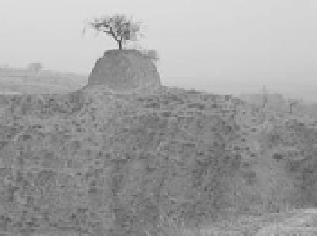Environmental Engineering Reference
In-Depth Information
(a) (b)
(c) (d)
Fig. 2.26
(a) Effect of quarrying on vegetation. To mitigate the effect of quarrying on the vegetation workers
transport soil to the quarry face and plant grasses to green the quarry; (b) Road construction causing forest damage;
(c) Farmers reclaim the slope land for agriculture and some trees have been removed; (d) Goats eat buds and leaves
of shrubs, intense grazing impairs vegetation
Mining
—Exploration, extraction, processing, and transportation of coal, minerals, sand and gravel,
and other materials have had and continue to have a profound effect on vegetation. Surface mining
methods include strip mining, open-pit operations, placer mining, and hydraulic mining. Such mining
activity has frequently resulted in destruction of vegetation. In some cases today, mining operations still
disturb most or all of entire watersheds. Mining can often remove large areas of vegetation at the mine
site, transportation facilities, processing plant, tailings piles, and related activities. Reduced shade can
increase water temperatures enough to harm aquatic species. Loss of cover vegetation, poor-quality water,
changes in food availability, and disruption of migration can have serious effects on terrestrial wildlife.
Species composition may change significantly. Transportation, staging, loading, processing, and similar
activities cause extensive changes to soils including loss of top-soil and soil compaction. Direct
displacement for construction of facilities reduces the number of productive soil acres in the watershed,
as does covering of productive soil by materials such as tailings. These activities decrease infiltration,
increase runoff, accelerate erosion, and increase sedimentation
Water and soils are contaminated by acid mine drainage (AMD) and the materials used in mining.
Acid mining drainage, formed from the oxidation of sulfide minerals like pyrite, is widespread. Many
hard rock mines are located in iron sulfide deposits. Upon exposure to water and air, such deposits
undergo sulfide oxidation with attendant release of iron, toxic metals (lead, copper, zinc), and excessive
acidity. Mercury was often used to separate gold from the ore; therefore, mercury was also lost into
streams. Present-day miners using suction dredges often find considerable quantities of mercury still
resident in streambeds. Current heap-leaching methods use cyanide to extract gold from low-quality ores.
This poses a special risk if operations are not carefully managed. Toxic runoff or precipitates can kill










































Search WWH ::

Custom Search